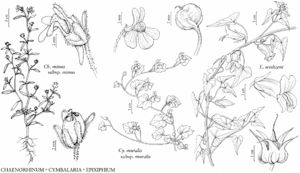Epixiphium
Proc. Calif. Acad. Sci., ser. 4, 15: 380. 1926.
| Taxon | Illustrator ⠉ | |
|---|---|---|
 | Chaenorhinum minus subsp. minus Cymbalaria muralis subsp. muralis Epixiphium wislizeni | Yevonn Wilson-Ramsey Barbara Alongi Barbara Alongi |
Herbs, annual, taprooted. Stems climbing or scrambling, glabrous. Leaves cauline, alternate; petiole twining; blade fleshy, not leathery, margins entire. Inflorescences axillary, flowers solitary; bracts absent. Pedicels present; bracteoles absent. Flowers bisexual; sepals 5, distinct, lanceolate, calyx radially symmetric, campanulate; corolla blue to violet, bilaterally symmetric, bilabiate, tubular, tube base not spurred or gibbous, lobes 5, abaxial 3, adaxial 2; stamens 4, basally adnate to corolla, didynamous, filaments basally hairy; staminode 1, filamentous; ovary 2-locular, placentation axile; stigma 2-lobed. Fruits capsules, dehiscence loculicidal. Seeds 100–200, dark-brown, ovoid-ellipsoid, wings present. x = 12.
Distribution
sw, sc United States, n Mexico
Discussion
Species 1.
Epixiphium is defined by distinctive characteristics in Antirrhineae: annual life cycle, taproots, keeled sepals, indurate capsules with regular transverse dehiscence, persistent style bases, and winged seeds. Based on this morphological distinctness, Epixiphium has been recognized either as a section or subgenus within Maurandya or as a genus. The latter view is adopted here based on the number of unique morphological characteristics. In phylogenetic studies based on morphological data, Epixiphium is either part of a trichotomy with Lophospermum D. Don and Rhodochiton Zuccarini ex Otto & A. Dietrich and sister to a Maurandya and Maurandella clade (M. Ghebrehiwet et al. 2000) or is basal within a Maurandya clade (W. J. Elisens 1985). Molecular ITS data placed Epixiphium in the Cymbalaria clade (M. Fernández-Mazuecos et al. 2013), sister to six other genera in a subclade that was sister to Asarina and Cymbalaria. Epixiphium wislizeni has not been included in phylogenetic studies using molecular data.
Selected References
None.